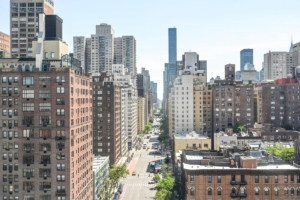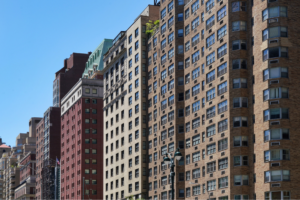The StreetEasy Market Reports include extensive data and analysis for Manhattan and Brooklyn broken down by neighborhood, home type, and bedroom size. The analysis below explores top line trends for each borough. To explore more data and all of October’s key market trends, see the last chart at the end of this post.
Upper Manhattan and East Brooklyn Sales Prices Rising the Fastest
Sale prices continued their climb across Manhattan and Brooklyn in October as inventory fell below last year’s levels in both boroughs. In Manhattan, the median resale price is poised to reach the $1 million mark soon, falling just $15,000 short in October. In Manhattan, the median resale price grew 6.4 percent from last year to $985,144 according to StreetEasy’s Manhattan Price Index. The median resale price in Brooklyn grew 10 percent from last year to $548,290, according to StreetEasy’s Brooklyn Price Index.
Amid high prices and lower inventory in Manhattan’s Downtown and Midtown submarkets as well as Brooklyn’s North and Northwest submarkets, many homebuyers have taken their search to Upper Manhattan and East Brooklyn in search for affordable options. In both markets, sale and rent prices remained well below their respective borough medians, but they posted among the highest annual growth rates in rent and sale prices in October. More than tripling Manhattan’s growth rate, Upper Manhattan continued its strong price growth momentum in October with a red-hot 20.4 percent increase in median resale price. Shrinking inventory and increased demand among buyers searching for relative value above 110th Street in Manhattan fueled the submarket’s remarkable growth in October.
In Brooklyn, the strongest growth was seen in the East Brooklyn submarket, where the median resale price grew 19.1 percent to $441,033, nearly double the Brooklyn-wide pace, followed by North Brooklyn and South Brooklyn, which both saw 4.1 percent growth.
[tableau server=”public.tableau.com” workbook=”priceIndices” view=”StreetEasyPriceIndex” tabs=”no” toolbar=”no” revert=”” refresh=”yes” linktarget=”” width=”600px” height=”730px”][/tableau]
East Brooklyn Leads in Annual Rent Growth in October
Rents in Upper Manhattan and East Brooklyn also outpaced rents in their respective boroughs, according to the new StreetEasy Rent Indices. Manhattan median rent rose 5.6 percent from last year to $3,158, according to StreetEasy’s Manhattan Rent Index. The strongest growth was seen in Upper Manhattan, where the median rent rose 7.7 percent to $2,333, followed by Upper East Side (6.7 percent) and Upper West Side (6 percent).
Rent growth in Brooklyn was slow by comparison, rising 3.2 percent from last year to a median of $2,672, according to StreetEasy’s Brooklyn Rent Index. Annual rent growth in East Brooklyn led both boroughs in October, rising 7.9 percent to $2,573, followed by North Brooklyn and South Brooklyn (both 4.1 percent).
Dwindling Co-op Listings Send Total Inventory Down in Manhattan and Brooklyn
Shrinking inventory is not a new trend in Manhattan. In fact, October sales inventory in the borough was 29.9 percent below its October 2010 level after years of steady decline. Total inventory fell 8.1 percent from last year to 8,055 listings, and the shrinkage had everything to do with disappearing co-op listings. The number of co-ops available saw a sharp 14.4 percent decline from last year and was 34.9 percent below its October 2010 level. All five Manhattan submarkets saw inventory declines throughout the month, but Upper Manhattan experienced the steepest drop as price growth there continues to gain steam. Total inventory in Upper Manhattan fell 28.8 percent from last year to 570 units.
Brooklyn saw a similar drop-off in co-op listings. The number of Brooklyn co-ops available fell 21.4 percent from last year, dragging overall inventory 3 percent below last year’s level. Condo inventory grew by 9.4 percent and townhouse inventory grew by 6.7 percent from last year. South Brooklyn was the only submarket to see a yearly decline in inventory, falling 9.6 percent. South Brooklyn accounts for nearly half of total Brooklyn’s market, so the moderate decline in listings there was enough to send total Brooklyn inventory below last year’s level.
The chart below shows the yearly inventory change among all submarkets in Manhattan and Brooklyn.
[tableau server=”public.tableau.com” workbook=”October2015MarketOverview” view=”inventoryWindow” tabs=”no” toolbar=”no” revert=”” refresh=”yes” linktarget=”” width=”600px” height=”570px”][/tableau]
Key Market Indicators Point to a More Competitive Manhattan Market
Key market indicators in October point to a slightly more competitive sales market in Manhattan than last year. Homes that sold in October spent a median time of 45 days on the market, one day shorter than last year. Home sellers also received more of their initial asking price. The median sale-to-list price ratio rose two points from last year to 100 percent, meaning home sellers could expect to receive their full asking price in October. Among Manhattan’s most competitive neighborhoods in October was Chelsea, where homes that sold in October typically spent 42 days on the market and sold for 1.5 percent above the seller’s initial asking price. Other hotly competitive neighborhoods were Lincoln Square, Upper West Side, and Gramercy Park. The least competitive neighborhood appeared to be Lenox Hill, where homes typically took 65 days to sell and sold for 2.7 percent less than the seller’s initial asking price.
[tableau server=”public.tableau.com” workbook=”October2015MarketOverview” view=”competitiveWindow” tabs=”no” toolbar=”no” revert=”” refresh=”yes” linktarget=”” width=”600px” height=”570px”][/tableau]
Key market indicators showed mixed results on Brooklyn’s competitiveness relative to last year. Homes that sold in October spent a median time of 42 days on the market, unchanged from last October. Home sellers also received slightly more of their initial asking price. The median sale-to-list price ratio rose 0.7 points from last year to 99 percent, meaning homes typically sold for 1 percent less than their initial asking price. The share of all listings available in October that saw a price cut also increased slightly from last year, rising 1.2 points to 26.9 percent. Among the most competitive neighborhoods in October was Park Slope, where homes that sold typically spent just 34 days on the market – the shortest time among all Manhattan and Brooklyn neighborhoods in October – and sold for just 1 percent below the seller’s initial asking price (on par with all Brooklyn homes). The least competitive market was Sheepshead Bay, where homes typically took exactly twice as long as all Brooklyn homes to sell (84 days) and did so with a 5.1 percent discount from the initial asking price (the lowest sale-to-list price ratio among all Manhattan and Brookyn neighborhoods).
Explore all of October’s key market trends in the charts below.
[tableau server=”public.tableau.com” workbook=”October2015MarketOverview” view=”October2015″ tabs=”no” toolbar=”no” revert=”” refresh=”yes” linktarget=”” width=”600px” height=”1000px”][/tableau]









